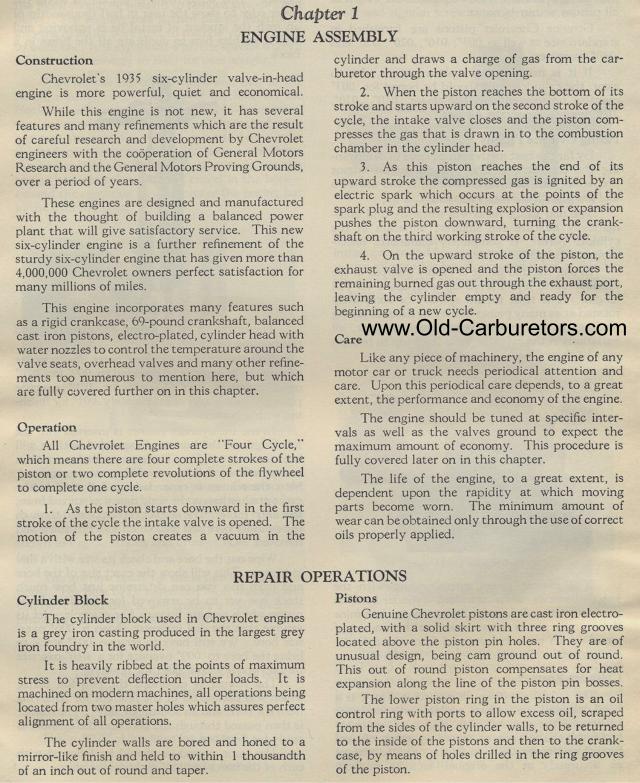Skip to: site menu | section menu | main content
1935 Chevy ENGINE Construction
Chevrolet's 1935 six-cylinder valve-in-head engine is more powerful,
quiet and economical.
While this engine is not new, it has several features and many refinements
which are the result of careful research and development by Chevrolet engineers
with the cooperation of General Motors Research and the General Motors Proving
Grounds, over a period of years.
These engines are designed and manufactured with the thought of building a balanced power plant that will give satisfactory service. This new six-cylinder engine is a further refinement of the sturdy six-cylinder engine that has given more than 4,000,000 Chevrolet owners perfect satisfaction for many millions of miles.
This engine incorporates many features such as a rigid crankcase,
69-pound crankshaft, balanced cast iron pistons, electroplated,
cylinder head with water nozzles to control the temperature around
the valve seats, overhead valves and many other refinements too
numerous to mention here, but which are fully covered further on
in this chapter.
Operation
All Chevrolet Engines are "Four Cycle," which means there
are four complete strokes of the piston or two complete revolutions
of the flywheel to complete one cycle.
1. As the piston starts downward in the first stroke of the cycle
the intake valve is opened. The motion of the piston creates a
vacuum in the
ASSEMBLY
cylinder and draws a charge of gas from the carburetor through
the valve opening.
2. When the piston reaches the bottom of its stroke and starts
upward on the second stroke of the cycle, the intake valve closes
and the piston compresses the gas that is drawn in to the combustion
chamber in the cylinder head.
3. As this piston reaches the end of its upward stroke the compressed
gas is ignited by an electric spark which occurs at the points
of the spark plug and the resulting explosion or expansion pushes
the piston downward, turning the crank-shaft on the third working
stroke of the cycle.
4. On the upward stroke of the piston, the exhaust valve is opened
and the piston forces the remaining burned gas out through the
exhaust port, leaving the cylinder empty and ready for the beginning
of a new cycle.
Care
Like any piece of machinery, the engine of any motor car or truck
needs periodical attention and care. Upon this periodical care
depends, to a great extent, the performance and economy of the
engine.
The engine should be tuned at specific intervals as well as the
valves ground to expect the maximum amount of economy. This procedure
is fully covered later on in this chapter.
The life of the engine, to a great extent, is dependent upon the
rapidity at which moving parts become worn. The minimum amount
of wear can be obtained only through the use of correct oils properly
applied.
REPAIR OPERATIONS
Cylinder Block
The cylinder block used in Chevrolet engines is a grey iron casting
produced in the largest grey iron foundry in the world.
It is heavily ribbed at the points of maximum stress to prevent
deflection under loads. It is machined on modern machines, all
operations being located from two master holes which assures perfect
alignment of all operations.
The cylinder walls are bored and honed to a mirror-like finish
and held to within 1 thousandth of an inch out of round and taper.
5Pistons
Genuine Chevrolet pistons are cast iron electroplated, with a solid
skirt with three ring grooves located above the piston pin holes.
They are of unusual design, being cam ground out of round. This
out of round piston compensates for heat expansion along the line
of the piston pin bosses.
The lower piston ring in the piston is an oil control ring with
ports to allow excess oil, scraped from the sides of the cylinder
walls, to be returned to the inside of the pistons and then to
the crank-case, by means of holes drilled in the ring grooves of
the piston.
